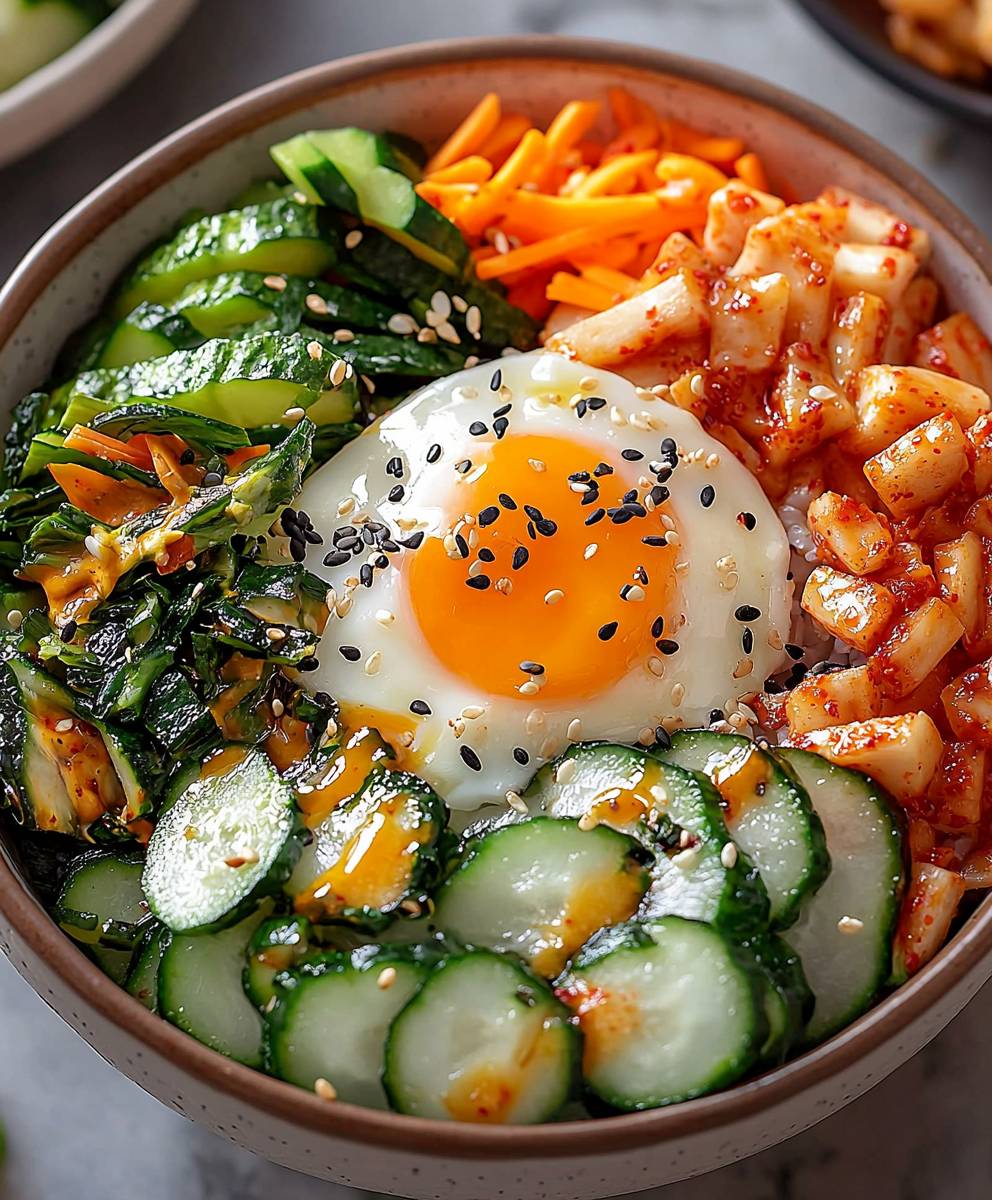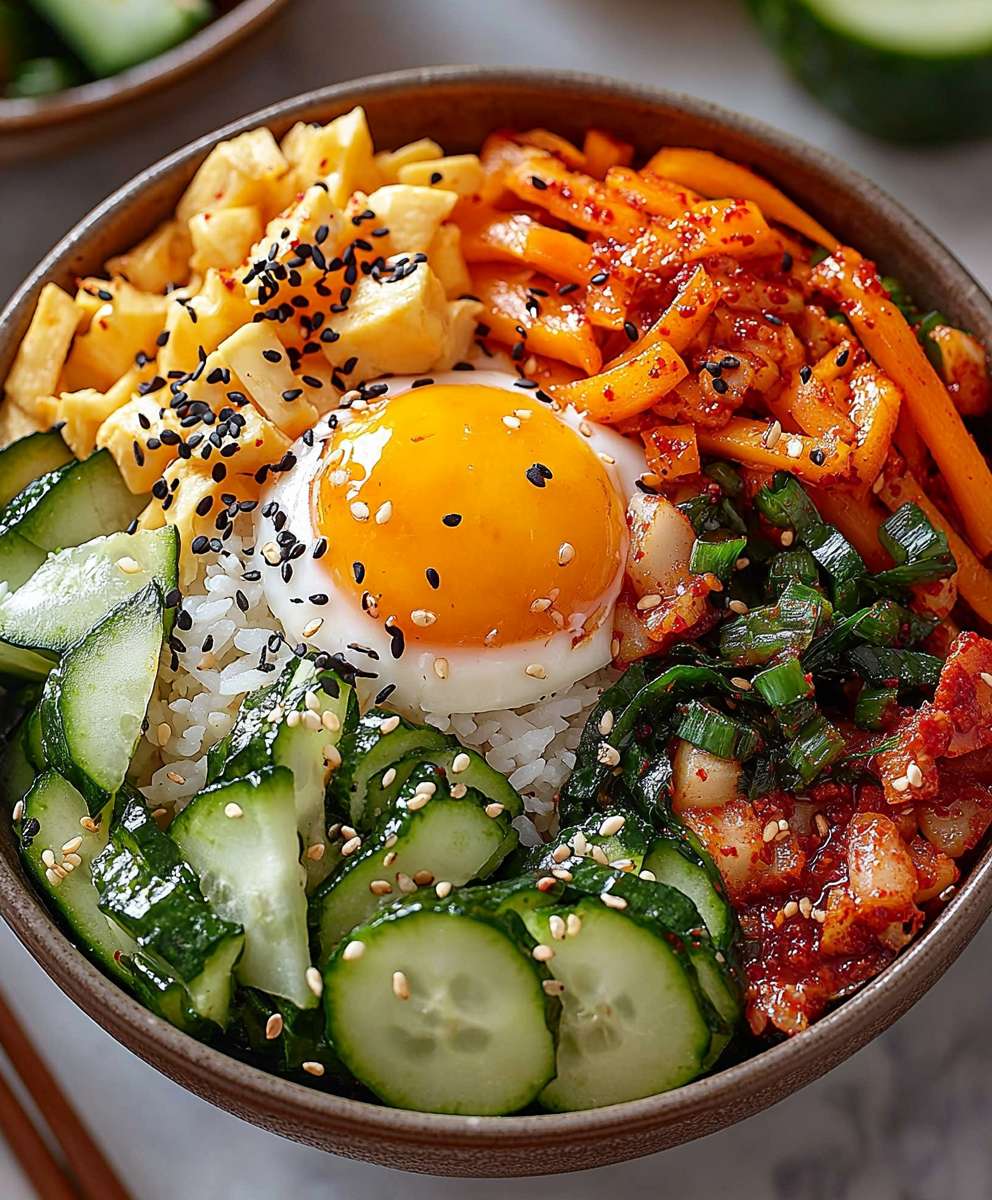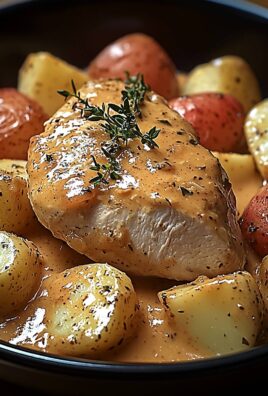Korean Veggie Bibimbap, a vibrant and nourishing dish, is about to become your new favorite weeknight meal! Imagine a bowl overflowing with colorful, perfectly seasoned vegetables, fluffy rice, a drizzle of savory-sweet sauce, and a perfectly fried egg with a runny yolk just waiting to be broken. Are you drooling yet? I know I am!
Bibimbap, meaning “mixed rice,” has deep roots in Korean culinary history. Some believe it originated as a way to use up leftover banchan (side dishes) during the Joseon Dynasty. Others suggest it was a peasant dish, a hearty and affordable way to nourish farmers after a long day in the fields. Whatever its true origin, Bibimbap has evolved into a beloved national dish, celebrated for its versatility and balanced flavors.
What makes Korean Veggie Bibimbap so irresistible? It’s the symphony of textures and tastes! The crispness of the vegetables, the soft chewiness of the rice, the richness of the egg yolk, and the umami-packed gochujang sauce create an explosion of flavor in every bite. Plus, it’s incredibly customizable! You can easily adapt it to your dietary needs and preferences, using whatever vegetables you have on hand. It’s also a fantastic way to sneak in extra veggies for picky eaters (trust me, they won’t even notice!). Get ready to experience the magic of Bibimbap your taste buds will thank you!
Ingredients:
- For the Rice:
- 2 cups short-grain rice
- 2 1/2 cups water
- For the Vegetables:
- 1 large carrot, julienned
- 1 cucumber, julienned
- 1 cup spinach, washed and trimmed
- 1 cup bean sprouts, washed
- 1 cup shiitake mushrooms, sliced
- 1/2 cup pickled radish (danmuji), thinly sliced
- 1/2 cup kimchi, chopped (optional)
- For the Seasoning (Vegetables):
- 1 tablespoon sesame oil, divided
- 1 tablespoon soy sauce, divided
- 1 teaspoon minced garlic, divided
- 1/2 teaspoon sugar, divided
- Pinch of salt, divided
- Pinch of black pepper, divided
- For the Gochujang Sauce:
- 2 tablespoons gochujang (Korean chili paste)
- 1 tablespoon sesame oil
- 1 tablespoon rice vinegar
- 1 tablespoon honey or maple syrup
- 1 teaspoon minced garlic
- 1 teaspoon sesame seeds
- 1/2 teaspoon water (or more, to adjust consistency)
- For Garnish:
- 2 tablespoons sesame seeds, toasted
- 2 green onions, thinly sliced
- 2 fried eggs (optional)
Preparing the Rice
Okay, let’s start with the foundation of our Bibimbap the rice! This is super important, as the rice needs to be perfectly cooked and slightly sticky to hold everything together. Don’t worry, it’s easier than it sounds!
- Rinse the Rice: Place the rice in a fine-mesh sieve and rinse under cold running water until the water runs clear. This usually takes about 2-3 minutes. Rinsing removes excess starch, which helps prevent the rice from becoming too gummy.
- Cook the Rice: In a medium saucepan, combine the rinsed rice and water. Bring to a boil over medium-high heat. Once boiling, reduce the heat to low, cover tightly, and simmer for 15-20 minutes, or until all the water is absorbed. Do not lift the lid during this time! This is crucial for even cooking.
- Rest the Rice: After 15-20 minutes, remove the saucepan from the heat and let it sit, covered, for another 10 minutes. This allows the rice to steam and finish cooking completely.
- Fluff the Rice: After the resting period, gently fluff the rice with a fork. This separates the grains and prevents them from sticking together too much. Keep the rice warm until ready to assemble the Bibimbap.
Preparing the Vegetables
Now for the fun part prepping the vibrant and delicious vegetables! Each vegetable is seasoned separately to bring out its unique flavor and texture. This might seem like a lot of steps, but trust me, it’s worth it!
- Prepare the Carrots: Heat 1/4 tablespoon of sesame oil in a skillet over medium heat. Add the julienned carrots and cook for 2-3 minutes, or until slightly softened. Season with 1/4 tablespoon of soy sauce, 1/4 teaspoon of minced garlic, a pinch of salt, and a pinch of black pepper. Stir well and remove from the skillet. Set aside.
- Prepare the Cucumber: In the same skillet, heat another 1/4 tablespoon of sesame oil. Add the julienned cucumber and cook for 1-2 minutes, just until slightly softened but still crisp. Season with 1/4 tablespoon of soy sauce, 1/4 teaspoon of minced garlic, a pinch of salt, and a pinch of black pepper. Stir well and remove from the skillet. Set aside.
- Prepare the Spinach: Bring a pot of water to a boil. Add the spinach and cook for 30 seconds, or until wilted. Immediately drain the spinach and rinse with cold water to stop the cooking process. Squeeze out any excess water. In a small bowl, combine the spinach with 1/4 tablespoon of sesame oil, 1/4 tablespoon of soy sauce, 1/4 teaspoon of minced garlic, a pinch of salt, and a pinch of black pepper. Mix well and set aside.
- Prepare the Bean Sprouts: Bring a pot of water to a boil. Add the bean sprouts and cook for 2-3 minutes, or until tender-crisp. Drain the bean sprouts and rinse with cold water. In a small bowl, combine the bean sprouts with 1/4 tablespoon of sesame oil, 1/4 tablespoon of soy sauce, 1/4 teaspoon of minced garlic, a pinch of salt, and a pinch of black pepper. Mix well and set aside.
- Prepare the Shiitake Mushrooms: Heat the remaining 1/4 tablespoon of sesame oil in the skillet. Add the sliced shiitake mushrooms and cook for 5-7 minutes, or until softened and slightly browned. Season with the remaining 1/4 tablespoon of soy sauce, 1/4 teaspoon of minced garlic, 1/2 teaspoon of sugar, a pinch of salt, and a pinch of black pepper. Stir well and remove from the skillet. Set aside.
- Prepare the Pickled Radish (Danmuji): If using pre-sliced danmuji, simply arrange it on a plate. If using a block of danmuji, slice it thinly. No cooking or seasoning is required for this ingredient.
- Prepare the Kimchi (Optional): If using kimchi, chop it into smaller pieces. Kimchi is already seasoned, so no additional seasoning is needed.
Making the Gochujang Sauce
The Gochujang sauce is what brings everything together! It’s spicy, sweet, and savory, and it adds that signature Korean flavor to the Bibimbap. You can adjust the amount of gochujang to your liking, depending on how spicy you want it.
- Combine the Ingredients: In a small bowl, combine the gochujang, sesame oil, rice vinegar, honey (or maple syrup), minced garlic, sesame seeds, and water.
- Mix Well: Stir all the ingredients together until well combined. Taste and adjust the seasoning as needed. If the sauce is too thick, add a little more water until you reach your desired consistency. It should be thick enough to coat the vegetables but thin enough to drizzle.
Assembling the Bibimbap
Finally, the moment we’ve all been waiting for assembling the Bibimbap! This is where you get to be creative and arrange the ingredients in a visually appealing way. The goal is to create a beautiful and delicious bowl that you can’t wait to dig into.
- Prepare the Bowls: Divide the cooked rice evenly among two bowls.
- Arrange the Vegetables: Arrange the prepared vegetables (carrots, cucumber, spinach, bean sprouts, shiitake mushrooms, pickled radish, and kimchi, if using) around the rice in separate sections. Try to create a colorful and balanced presentation.
- Add the Gochujang Sauce: Drizzle the gochujang sauce over the vegetables and rice. You can add as much or as little as you like, depending on your spice preference.
- Garnish: Sprinkle toasted sesame seeds and sliced green onions over the Bibimbap.
- Add the Egg (Optional): If desired, top each bowl with a fried egg. The runny yolk adds richness and flavor to the dish.
- Serve and Enjoy: Serve the Bibimbap immediately. To eat, mix all the ingredients together thoroughly before enjoying. This ensures that every bite is packed with flavor!

Conclusion:
This isn’t just another recipe; it’s an invitation to experience the vibrant flavors and textures of Korea right in your own kitchen. I truly believe this Korean Veggie Bibimbap is a must-try for anyone looking for a healthy, satisfying, and utterly delicious meal. The combination of colorful vegetables, savory gochujang sauce, and perfectly cooked rice creates a symphony of tastes that will leave you wanting more. It’s a dish that’s both comforting and exciting, familiar yet refreshingly different.
Think of it: the slight sweetness of the carrots, the earthy notes of the mushrooms, the crispness of the spinach, all brought together by the umami-rich gochujang. It’s a culinary adventure in every bite! And the best part? It’s incredibly versatile.
Serving Suggestions and Variations:
While I’ve shared my favorite combination of vegetables, feel free to get creative and adapt the recipe to your liking. Don’t be afraid to experiment with different veggies based on what’s in season or what you have on hand. Bean sprouts, zucchini, or even some thinly sliced bell peppers would be fantastic additions.
For a heartier meal, consider adding a fried egg on top. The runny yolk adds a richness and creaminess that complements the other ingredients beautifully. If you’re not vegetarian, you could also add some thinly sliced bulgogi or grilled chicken for extra protein.
And speaking of protein, tofu is another excellent option. Marinate some firm tofu in a mixture of soy sauce, sesame oil, and garlic, then pan-fry or bake it until golden brown. It’s a delicious and satisfying way to add protein to your bibimbap.
If you’re looking for a spicier kick, add a little extra gochujang to your sauce or sprinkle some gochugaru (Korean chili flakes) on top. For a milder flavor, you can reduce the amount of gochujang or add a touch of honey or maple syrup to the sauce.
Don’t forget the toppings! A sprinkle of sesame seeds and a drizzle of sesame oil are essential for adding flavor and aroma. You can also add some chopped green onions for a fresh, vibrant touch.
I often like to serve my bibimbap with a side of kimchi. The tangy, spicy kimchi provides a wonderful contrast to the other flavors and adds another layer of complexity to the meal. A simple cucumber salad would also be a refreshing accompaniment.
Ready to Dive In?
I’m so excited for you to try this recipe and experience the magic of Korean Veggie Bibimbap for yourself. It’s a dish that’s perfect for a weeknight dinner, a weekend lunch, or even a potluck gathering. It’s sure to impress your friends and family with its vibrant flavors and beautiful presentation.
Once you’ve made it, I’d absolutely love to hear about your experience! Did you make any modifications? What were your favorite vegetables to use? Did you add a fried egg? Share your photos and stories in the comments below. I’m always eager to learn from your culinary adventures and see how you’ve made this recipe your own.
So, what are you waiting for? Gather your ingredients, put on some music, and get ready to create a delicious and unforgettable meal. Happy cooking! I’m confident that this will become a new favorite in your recipe repertoire. Enjoy!
Korean Veggie Bibimbap: A Delicious and Healthy Recipe
Korean Bibimbap with seasoned vegetables, gochujang sauce, and a fried egg, served over warm rice.
Ingredients
- 2 cups short-grain rice
- 2 1/2 cups water
- 1 large carrot, julienned
- 1 cucumber, julienned
- 1 cup spinach, washed and trimmed
- 1 cup bean sprouts, washed
- 1 cup shiitake mushrooms, sliced
- 1/2 cup pickled radish (danmuji), thinly sliced
- 1/2 cup kimchi, chopped (optional)
- 1 tablespoon sesame oil, divided
- 1 tablespoon soy sauce, divided
- 1 teaspoon minced garlic, divided
- 1/2 teaspoon sugar, divided
- Pinch of salt, divided
- Pinch of black pepper, divided
- 2 tablespoons gochujang (Korean chili paste)
- 1 tablespoon sesame oil
- 1 tablespoon rice vinegar
- 1 tablespoon honey or maple syrup
- 1 teaspoon minced garlic
- 1 teaspoon sesame seeds
- 1/2 teaspoon water (or more, to adjust consistency)
- 2 tablespoons sesame seeds, toasted
- 2 green onions, thinly sliced
- 2 fried eggs (optional)
Instructions
- Prepare the Rice: Rinse the rice under cold water until the water runs clear. Combine rice and water in a saucepan. Bring to a boil, then reduce heat to low, cover, and simmer for 15-20 minutes, or until water is absorbed. Remove from heat and let sit, covered, for 10 minutes. Fluff with a fork.
- Prepare the Carrots: Heat 1/4 tablespoon sesame oil in a skillet. Add carrots and cook for 2-3 minutes. Season with 1/4 tablespoon soy sauce, 1/4 teaspoon garlic, salt, and pepper. Set aside.
- Prepare the Cucumber: Heat 1/4 tablespoon sesame oil in the skillet. Add cucumber and cook for 1-2 minutes. Season with 1/4 tablespoon soy sauce, 1/4 teaspoon garlic, salt, and pepper. Set aside.
- Prepare the Spinach: Boil spinach for 30 seconds. Drain and rinse with cold water. Squeeze out excess water. Combine with 1/4 tablespoon sesame oil, 1/4 tablespoon soy sauce, 1/4 teaspoon garlic, salt, and pepper. Set aside.
- Prepare the Bean Sprouts: Boil bean sprouts for 2-3 minutes. Drain and rinse with cold water. Combine with 1/4 tablespoon sesame oil, 1/4 tablespoon soy sauce, 1/4 teaspoon garlic, salt, and pepper. Set aside.
- Prepare the Shiitake Mushrooms: Heat 1/4 tablespoon sesame oil in the skillet. Add mushrooms and cook for 5-7 minutes. Season with 1/4 tablespoon soy sauce, 1/4 teaspoon garlic, 1/2 teaspoon sugar, salt, and pepper. Set aside.
- Prepare the Pickled Radish (Danmuji): Slice thinly if needed.
- Prepare the Kimchi (Optional): Chop into smaller pieces.
- Make the Gochujang Sauce: Combine gochujang, sesame oil, rice vinegar, honey (or maple syrup), garlic, sesame seeds, and water in a bowl. Mix well. Adjust consistency with more water if needed.
- Assemble the Bibimbap: Divide rice into bowls. Arrange vegetables around the rice. Drizzle with gochujang sauce. Garnish with sesame seeds and green onions. Top with a fried egg (optional).
- Serve and Enjoy: Mix all ingredients together before eating.
Notes
- Rinsing the rice is crucial for preventing it from becoming too gummy.
- Do not lift the lid while the rice is simmering.
- Season each vegetable separately to enhance its flavor.
- Adjust the amount of gochujang sauce to your spice preference.
- The runny yolk from the fried egg adds richness to the dish.




